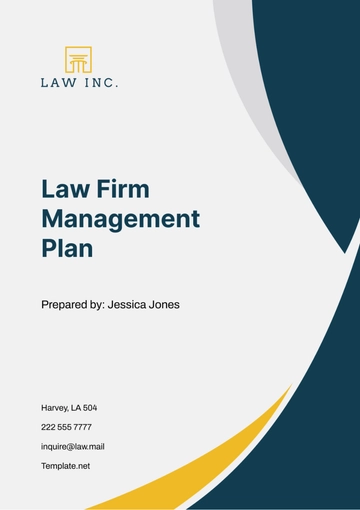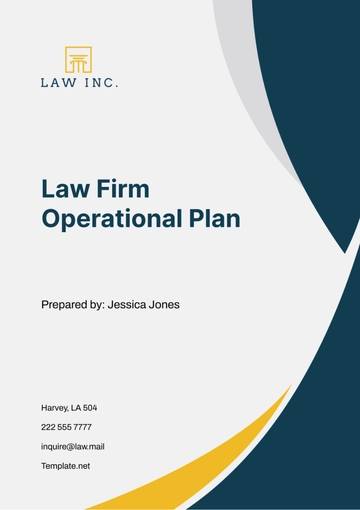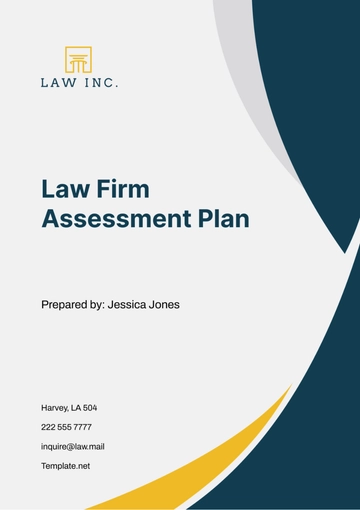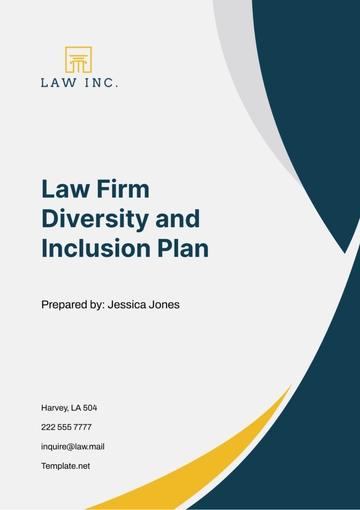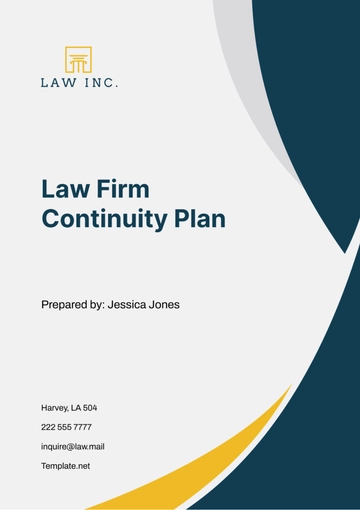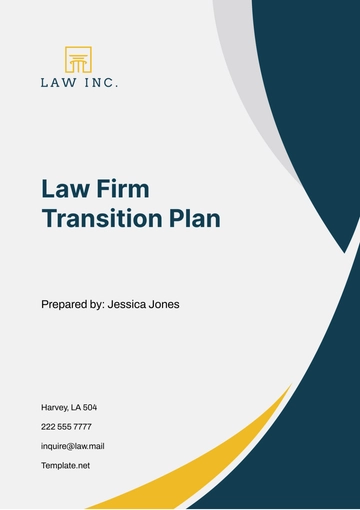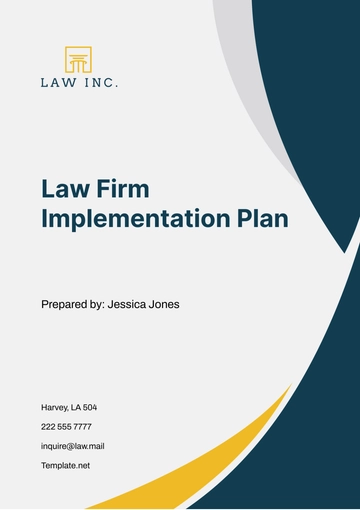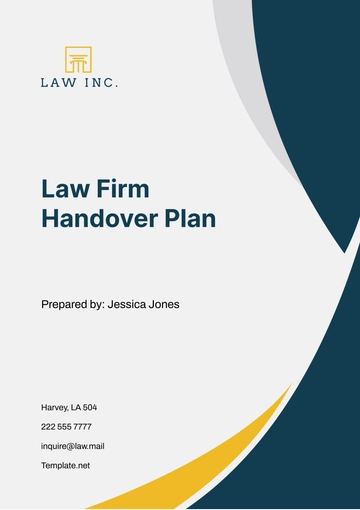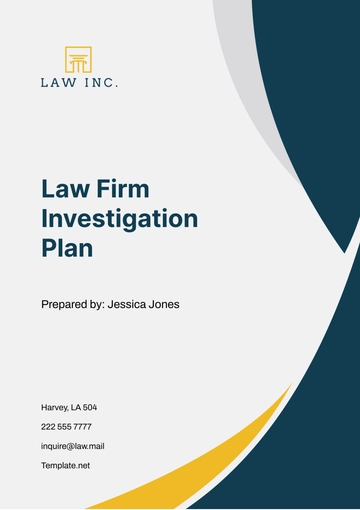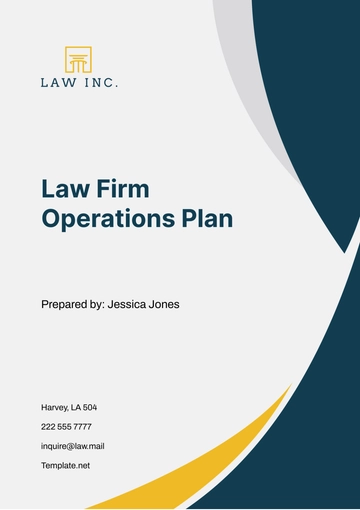Free Law Firm Operational Plan
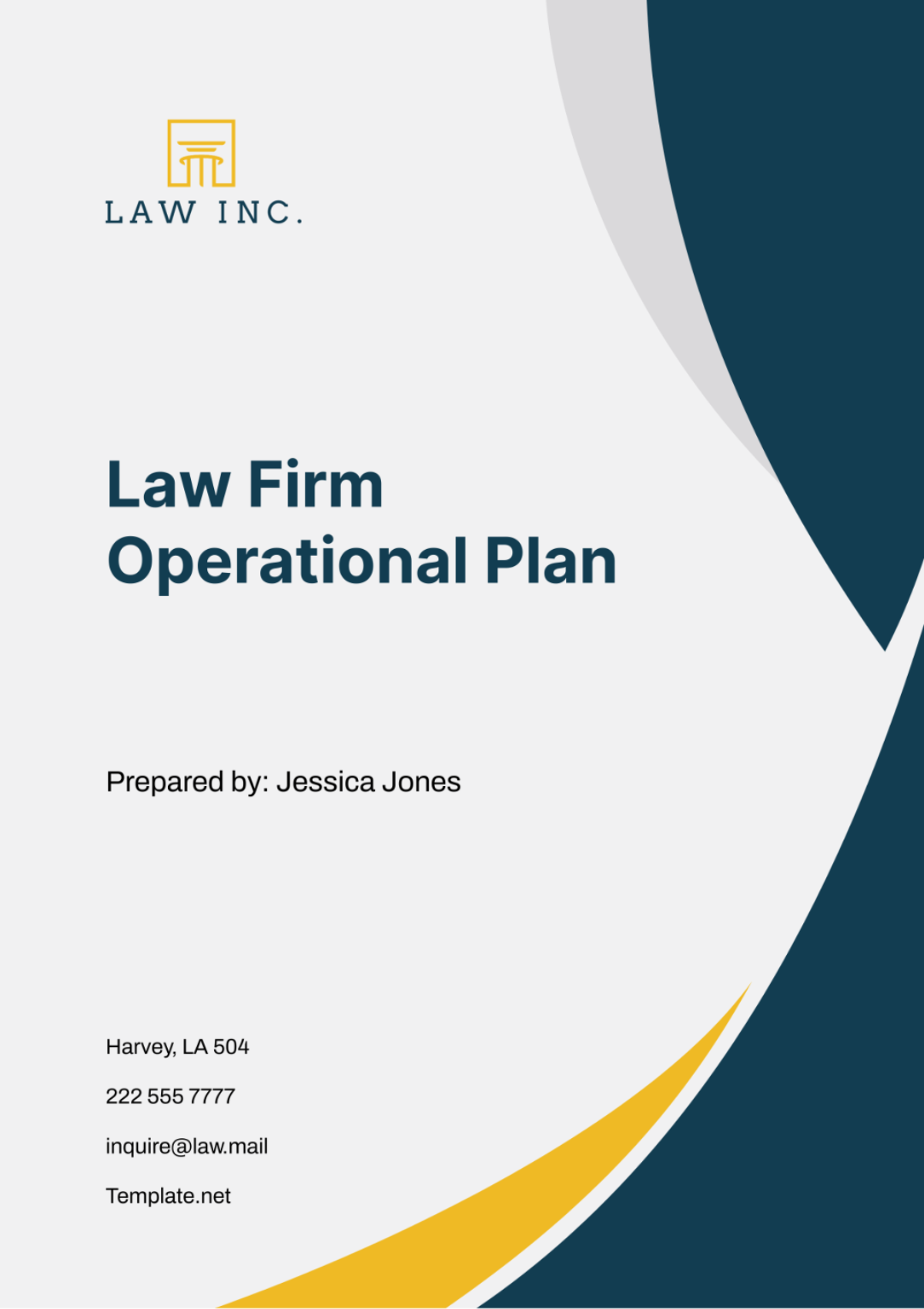
1. Executive Summary
Mission Statement: "To deliver unparalleled legal solutions through dedication to excellence and integrity."
Vision Statement: "To set the standard for legal excellence and client service nationally, while fostering an environment of innovation and inclusiveness."
Core Values: Commitment to justice, integrity, professionalism, and client satisfaction are the pillars that uphold our daily operations and long-term strategic goals.
Objective: The primary aim of this operational plan is to enhance service delivery across all client interactions, optimize internal processes for greater efficiency, and strategically expand our market presence. The plan outlines detailed actions and resource allocations to achieve these objectives over the next fiscal year.
2. Strategic Context
Current Market Position: Currently, [Your Company Name] holds a commendable position in the legal market specializing in corporate law, intellectual property, and family law. Despite a solid client base and respected market presence, the evolving legal landscape and increasing competition necessitate a strategic operational overhaul to maintain and enhance our market standing.
Industry Trends: Recent trends indicate a surge in demand for legal services that incorporate digital solutions such as virtual consultations and AI-based case management. Additionally, clients increasingly prefer law firms with transparent billing practices and robust data protection measures.
Previous Year Recap: The last fiscal year saw a 10% growth in our client base, but highlighted areas needing improvement, particularly in digital transformation and client communication efficiency.
3. Key Objectives
Our key objectives for the coming year focus on targeted growth, operational efficiency, and client engagement:
Client Retention and Acquisition: By implementing improved and more effective engagement strategies, we aim to increase our client retention rate by 20%. Furthermore, we also plan on breaking into developing markets and introducing practices in new areas. Through these efforts, we are expecting to acquire an increase of 30% in our new client base.
Operational Efficiency: We are proposing to implement sophisticated case management software. The primary motivation for this implementation is to increase efficiency, effectively reducing the time spent handling each case by a significant 15%. Additionally, through innovative resource management strategies integrated into this system, we predict a reduction in operational costs of approximately 10%. Thus, the progressive software's key objective is to streamline workflow, facilitate speedy case resolution, and ultimately deliver substantial financial savings.
Digital Transformation: We aim to fully incorporate digital operations into our everyday processes, such as client management, internal communications, and handling of documents. This transition to digital will not only enhance accessibility and convenience for everyone involved but also contribute to our ongoing commitment to reduce our ecological footprint. By leveraging the benefits of technology, we can minimize the use of paper and physical resources, thereby playing a role in the reduction of environmental harm. This integration will ensure a streamlined, efficient approach to our work while also taking a step towards environmental conservation.
4. Organizational Structure
Position | Responsibility | Reports To |
|---|---|---|
Managing Partner | Oversees firm strategy, major operations, performance | Board of Directors |
Operations Manager | Manages daily operations, admin staff coordination | Managing Partner |
IT Director | Leads tech initiatives, manages IT infrastructure | Managing Partner |
HR Manager | Handles recruitment, training, and employee relations | Managing Partner |
5. Operations Management
Case Management Processes: Each case will be tracked using our new comprehensive case management system, from intake through resolution, ensuring that all steps are documented, deadlines are met, and clients are kept informed throughout the process.
Client Intake and Communication Protocols: Streamlining client intake by using automated systems for initial data collection and follow-up, ensuring a seamless integration into our case management process. Regular updates and strategic communication protocols will be enforced to enhance client satisfaction.
File Handling and Document Management Systems: The process of implementing a state-of-the-art digital filing system is one that will guarantee quick and easy access to files. It also promises utmost security against breaches and unnecessary intrusions. Moreover, this digital filing system will stringently comply with all the regulatory requirements that exist to document handling and storage. The system's compliance ensures that the documents are handled and stored in a manner that adheres to laws and regulations, making it a foolproof system for storing information.
6. Human Resources
Staffing Requirements: A projected increase in caseloads necessitates the hiring of three more associate attorneys and two paralegals to maintain our service standards without overburdening current staff.
Recruitment, Training, and Retention Strategies: We will enhance our recruitment process to attract top talent by partnering with leading law schools and using targeted social media campaigns. A continuous training program will be developed to keep our team at the forefront of legal developments and innovative practices.
Performance Management and Evaluation Systems: A detailed performance evaluation system will be implemented, featuring bi-annual reviews that measure individual contributions against firm-wide goals, focusing on areas such as client satisfaction, billable hours, and professional development.
7. Technology Plan
Current and Upcoming IT Initiatives
Technology Area | Current State | Planned Upgrades | Estimated Cost |
|---|---|---|---|
CRM System | Basic version in use | Upgrade to advanced CRM for enhanced data analytics | $50,000 |
Cybersecurity | Standard security protocols in place | Advanced cybersecurity measures, regular audits | $25,000 |
Cybersecurity Measures and Data Protection Strategies
Strategy | Implementation Method | Goal |
|---|---|---|
Regular Security Audits | Conducted bi-annually by external security firms | Identify vulnerabilities, enhance security protocols |
Data Encryption | Apply state-of-the-art encryption to all client data | Protect client confidentiality and data integrity |
Employee Training | Ongoing cybersecurity training sessions for all employees | Ensure staff is aware of and practices data protection |
8. Financial Management
Budget for the Year
Forecasts concerning revenue and expenses are meticulously outlined and organized in a detailed manner to serve as references that guide the financial decisions and investments of the organization. The main objective for this practice is to ensure sustainability within the organization and to promote strategic growth in the long run. Apart from this, a contingency fund will be put into place to manage and cover unforeseen expenses that might arise unexpectedly. This contingency fund will function as an important tool providing critical financial stability, thus ensuring the organization is not thrown off balance financially in case of sudden, unplanned expenses.
Financial Controls and Auditing Procedures
Measures will be put in place to comprehensively control and oversee all financial transactions that occur. This will involve the institution of regular internal audits, as well as external audits. These consistent audit procedures are planned and designed with the intent of guaranteeing and maintaining complete fidelity to compliance protocols and upholding the highest level of financial integrity.
9. Risk Management
Identification of Risks: We have successfully identified several critical areas of risk that encompass a broad range of sectors such as compliance with all legalities, maintaining financial stability, ensuring absolute confidentiality for our clients, as well as managing the reputation of our organization. We acknowledge that each of these areas carries its own set of challenges and risks. In response to that, we have systematically associated every single one of these areas with a comprehensive set of risk mitigation strategies that are designed to safeguard the interests of our firm, in addition to those of our valued clients.
Strategies for Mitigating Risks: In order to mitigate these risks, we plan on implementing several strategies. First and foremost, we will engage in regular training sessions related to compliance in order to ensure that our team is well-versed in the necessary regulations and expectations. Secondly, we will enhance our financial control systems. By doing so, we aim to increase the reliability and accuracy of our financial transactions and reporting. In addition to these measures, we will also institute strict data protection protocols. These protocols are designed to safeguard our proprietary and sensitive information, thereby further reducing potential risks. Lastly, we also aim to proactively manage our relations with the public. By doing so, we hope to preemptively address any potential issues that could harm our reputation or standing. Through a combination of these strategies, we hope to effectively manage and mitigate potential risks.
10. Marketing and Business Development
Marketing Strategies and Campaigns: We will launch a multifaceted marketing campaign focusing on digital platforms to enhance our visibility. The campaign will highlight our firm’s expertise, successful case studies, and client testimonials to attract new clients.
Client Relationship Management and Retention Plans: We will introduce a client portal that allows clients to track their case progress, access documents, and communicate directly with their attorneys. This will improve transparency and increase client engagement and satisfaction.
New Market Exploration and Diversification Strategies: Plans to explore new practice areas such as environmental law and cybersecurity law are outlined, with market research scheduled to assess potential client demand and profitability.
11. Facilities and Administration
Office Management and Administrative Support
The facilities and administration section focuses on ensuring that the physical environment and support structures of [Your Company Name] are conducive to efficient operations and employee well-being. This encompasses not only the physical upkeep of the office space but also the implementation of administrative systems that enhance operational effectiveness.
Area | Responsibilities | Details |
|---|---|---|
Office Maintenance | Ensure all physical facilities are maintained and operational | Regular inspections and maintenance of HVAC, lighting, and office equipment |
Administrative Support | Provide necessary administrative assistance to all departments | Staffing of front desk, mail handling, supply procurement, and scheduling of shared spaces |
Technology Infrastructure | Oversee the maintenance and upgrade of office technology | Regular updates to software licenses, hardware upgrades, and troubleshooting |
Safety and Compliance | Ensure the office meets all safety regulations and legal compliance requirements | Regular safety drills, accessibility compliance checks, and environmental |
12. Performance Monitoring and Evaluation
KPIs and Benchmarks
KPI | Target | Measurement Tool |
|---|---|---|
Client Retention Rate | 85% | Client feedback surveys, CRM data analysis |
Case Turnaround Time | Reduce current average by 15% | Case management software, time tracking |
Operational Cost Reduction | Reduce costs by 10% | Financial software, cost analysis reports |
Review Intervals
Review Type | Frequency | Purpose |
|---|---|---|
Quarterly Reviews | Every 3 months | Assess short-term goals, operational efficiency |
Annual Reviews | Once a year | A comprehensive evaluation of yearly performance |
13. Contingency Planning
Plan for Unexpected Events
Event Type | Strategy | Resources Allocated |
|---|---|---|
Data Breach | Immediate IT response team activation, client notification | Emergency IT fund, dedicated response team |
Key Staff Departure | Succession planning, temporary staffing solutions | Training programs, partnership with staffing agencies |
Economic Downturn | Cost reduction strategies, diversification of services | Financial reserves, flexible operational plans |
Business Continuity Strategies
Strategy | Details | Implementation |
|---|---|---|
Remote Work Capabilities | Enable all staff to work remotely with full access | Invest in cloud technologies, secure remote access |
Emergency Fund | Maintain a fund equivalent to 6 months of operational costs | Regular contributions based on profit margins |
Cross-training Staff | Train staff across different operational roles | Scheduled training sessions, job rotation programs |
14. Conclusion
This comprehensive operational plan sets forth the strategies and actions [Your Company Name] will pursue to achieve excellence in service delivery, operational efficiency, and strategic growth. The commitment from every team member will be pivotal in realizing the objectives set forth in this plan, and we are confident in our collective ability to meet these challenges head-on.
- 100% Customizable, free editor
- Access 1 Million+ Templates, photo’s & graphics
- Download or share as a template
- Click and replace photos, graphics, text, backgrounds
- Resize, crop, AI write & more
- Access advanced editor
Streamline your operations with Template.net's Law Firm Operational Plan Template. Designed for precision and efficiency, this template is fully customizable and editable via our Ai Editor Tool. Develop and implement strategic operations to enhance productivity and service delivery. An indispensable tool for law firms aiming to optimize daily activities, exclusively available at Template.net.
You may also like
- Finance Plan
- Construction Plan
- Sales Plan
- Development Plan
- Career Plan
- Budget Plan
- HR Plan
- Education Plan
- Transition Plan
- Work Plan
- Training Plan
- Communication Plan
- Operation Plan
- Health And Safety Plan
- Strategy Plan
- Professional Development Plan
- Advertising Plan
- Risk Management Plan
- Restaurant Plan
- School Plan
- Nursing Home Patient Care Plan
- Nursing Care Plan
- Plan Event
- Startup Plan
- Social Media Plan
- Staffing Plan
- Annual Plan
- Content Plan
- Payment Plan
- Implementation Plan
- Hotel Plan
- Workout Plan
- Accounting Plan
- Campaign Plan
- Essay Plan
- 30 60 90 Day Plan
- Research Plan
- Recruitment Plan
- 90 Day Plan
- Quarterly Plan
- Emergency Plan
- 5 Year Plan
- Gym Plan
- Personal Plan
- IT and Software Plan
- Treatment Plan
- Real Estate Plan
- Law Firm Plan
- Healthcare Plan
- Improvement Plan
- Media Plan
- 5 Year Business Plan
- Learning Plan
- Marketing Campaign Plan
- Travel Agency Plan
- Cleaning Services Plan
- Interior Design Plan
- Performance Plan
- PR Plan
- Birth Plan
- Life Plan
- SEO Plan
- Disaster Recovery Plan
- Continuity Plan
- Launch Plan
- Legal Plan
- Behavior Plan
- Performance Improvement Plan
- Salon Plan
- Security Plan
- Security Management Plan
- Employee Development Plan
- Quality Plan
- Service Improvement Plan
- Growth Plan
- Incident Response Plan
- Basketball Plan
- Emergency Action Plan
- Product Launch Plan
- Spa Plan
- Employee Training Plan
- Data Analysis Plan
- Employee Action Plan
- Territory Plan
- Audit Plan
- Classroom Plan
- Activity Plan
- Parenting Plan
- Care Plan
- Project Execution Plan
- Exercise Plan
- Internship Plan
- Software Development Plan
- Continuous Improvement Plan
- Leave Plan
- 90 Day Sales Plan
- Advertising Agency Plan
- Employee Transition Plan
- Smart Action Plan
- Workplace Safety Plan
- Behavior Change Plan
- Contingency Plan
- Continuity of Operations Plan
- Health Plan
- Quality Control Plan
- Self Plan
- Sports Development Plan
- Change Management Plan
- Ecommerce Plan
- Personal Financial Plan
- Process Improvement Plan
- 30-60-90 Day Sales Plan
- Crisis Management Plan
- Engagement Plan
- Execution Plan
- Pandemic Plan
- Quality Assurance Plan
- Service Continuity Plan
- Agile Project Plan
- Fundraising Plan
- Job Transition Plan
- Asset Maintenance Plan
- Maintenance Plan
- Software Test Plan
- Staff Training and Development Plan
- 3 Year Plan
- Brand Activation Plan
- Release Plan
- Resource Plan
- Risk Mitigation Plan
- Teacher Plan
- 30 60 90 Day Plan for New Manager
- Food Safety Plan
- Food Truck Plan
- Hiring Plan
- Quality Management Plan
- Wellness Plan
- Behavior Intervention Plan
- Bonus Plan
- Investment Plan
- Maternity Leave Plan
- Pandemic Response Plan
- Succession Planning
- Coaching Plan
- Configuration Management Plan
- Remote Work Plan
- Self Care Plan
- Teaching Plan
- 100-Day Plan
- HACCP Plan
- Student Plan
- Sustainability Plan
- 30 60 90 Day Plan for Interview
- Access Plan
- Site Specific Safety Plan

